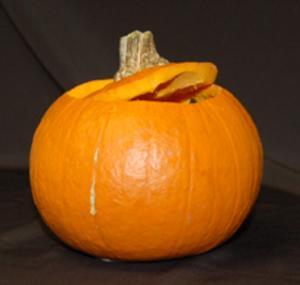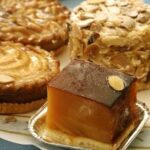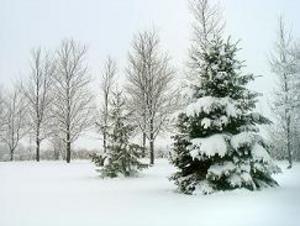When I was little, the day after Halloween my mother would take our Jack O’Lanterns and turn them into pumpkin pies. It seemed like magic and we enjoyed the pies even more, knowing they’d been our carved pumpkins only a few hours before!
I can demystify the steps to make your own, delicious, pumpkin pie. It isn’t terribly difficult, but it is important to follow each step fairly closely.
According to Wikipedia, “American colonists sliced off pumpkin tops; removed seeds and filled the insides with milk, spices and honey. This was baked in hot ashes and is the origin of pumpkin pie.” So that’s how it all started!
Wikipedia goes on to tell us that, “Pumpkin pie is a traditional North American dessert usually made in the late fall and early winter, especially for Halloween, Thanksgiving, and Christmas. The pie consists of a squash-based custard, ranging in color from orange to brown, baked in a single pie shell, rarely with a top crust. The pie is generally flavored with nutmeg, cinnamon, cloves and ginger and is traditionally served with whipped cream, although in parts of Canada, fans insist on accompanying pumpkin pie only with maple syrup. Though some cooks make this pie from scratch, it is common to buy canned pumpkin pie filling and follow the directions on the back of the can. Pumpkin pie is a seasonal product available in bakeries and grocery stores. Unfortunately, canned pumpkin puree is not widely available in stores outside the U.S.A. and Canada, so especially European tourists or exchange students once brought in contact with pumpkin pie and fallen into “pie addiction” have to make it from scratch once they return home. ”
Wikipedia also comments, “Contrary to popular belief, traditional jack-o’-lantern-type pumpkins make coarsely textured pies” I have found that the types of pumpkins available for Jack-O’-Lanterns vary so dramatically that some have made perfectly lovely pies and others were a bit on the stringy side. You never know what seeds the farmer used! If you have the opportunity to pick through a bunch of pumpkins at the store, by all means look for one with a firm but soft shell. If you can pierce the skin with your thumb nail, and it isn’t terribly hard under the skin, you may have a good pie pumpkin.
To demonstrate what can happen if you don’t do the right things, let me tell you about one of my most embarrassing moments in life, which occurred over a homemade pumpkin pie. I was a newly wed, enjoying my few homemaking skills. As Thanksgiving approached, we were invited to an employee group dinner. The employees were asked to please bring either a mince or a pumpkin pie. The rest of the dinner was going to be provided. I decided to make my very first homemade pumpkin pie from scratch. My mother did it often, how difficult could it be?!
I bought a pumpkin after Halloween and before Thanksgiving, and opened my brand new Joy of Cooking cookbook. I honestly tried to follow all the steps, but it lost me when I was told to put the peeled, cooked pumpkin pieces in a blender. I didn’ t own a blender! I tried mashing the pumpkin with a fork, but it was tough going. I tried pushing it through a sieve. It didn’t want to cooperate. I sliced it, whammed it, mushed and slushed it, and the pieces got smaller, but they stayed annoyingly lumpy. Finally, when nothing really worked very well, I gave up, and went on with the recipe, hoping the pie would improve over time and with baking.
It didn’t. It came out of the oven with a lovely, fancy crust, but the filling was still embarrassingly lumpy. I’d used dark brown sugar in the pie, so the lumpy pieces were pretty dark too. I didn’t want to take my lumpy pie to the dinner where everyone would see it, but my husband insisted. To this day I’m not sure whether he was so blindly proud of my efforts that he wanted to show them off, or whether he had decided to teach me a lesson. Whatever his reasoning he insisted on taking that awful pie.
Upon arriving at the dinner, we were sent to the kitchen to deposit the pie. Someone was cutting the pies as they came in, and arranging each piece on a plate. The plates were put on rolling double decker carts, ready for dessert time.
I dumped my pie and scuttled away from the kitchen. Hopefully no one would remember which one had brought the darn thing in!
The turkey dinner was good and I actually forgot all about my pie, until the dessert carts started arriving. The dessert servers asked each diner, “pumpkin or mince?” I heard a lot of “pumpkin” and an occasional “mince.” Then, in the wake of the rolling dessert cart came comments, “Hey! That’s NOT mince!” Uh-oh. They got a piece of my pie!
When the dessert cart got to us I was so irritated to hear my pumpkin pie described as mince! I started to say, “That’s not mince” but my husband kicked me – hard – under the table. I just said “mince” sulkily and ate my lumpy pie. I think my husband had the real, regular pumpkin. He was loyal, but he wasn’t a fool!
So what went wrong with my poor pie? First of all, the pumpkin meat was not cooked sufficiently. You know how hard a pumpkin shell is – that’s why you can carve beautiful patterns into it. Whether you are carving a face, or using wood working tools to carve a surface that is as intricate as a wood carving, the firm pumpkin meat is what allows you to do that.
One of the beauties of pumpkin is that after it is thoroughly cooked, it becomes softer (providing that you didn’t start out with a really hard shelled pumpkin) and can be made into a smooth puree, as smooth as applesauce. They key here is to thoroughly cook the pumpkin, but not overcook it. I admit: a blender is heaven-sent when it comes to pureeing something, which is to say, turning it to mush. However if you don’t own a blender, there are other options, and I’ll get into those in the recipe which follows.
So! Are you ready? Grab your pumpkins, folks, and here we go!
The first step is to clean out the pumpkin, if you haven’t already done so. If you are going to use the old Halloween Jack O’Lantern, please use it right after Halloween! Preferably the day after. You don’t want to bake with a squash (which is what a pumpkin is) which has been sitting around, exposed to the air for days on end! Check out the Jack O’Lantern: what worked as a Halloween pumpkin might not work for a pie = you need one which has a good amount of firm pumpkin meat (the orange part on the inside) which is not burned by a candle, or going mushy from age, yet isn’t rock hard.
If you are going to use a pumpkin which has not been carved for Halloween, you can either cut the top off of it and then scoop out the skeins and seeds with a serving spoon, or you can slice the pumpkin into quarters, like a huge apple, then clean out the skeins and seeds. Either way, the tough skeins on the inside need to be removed, and so do the seeds. Since the skeins grew inward from the pumpkin’s flesh, you will need to take a serving spoon and scrape the skeins off the insides of the pumpkin. The result needs to be a nice, smooth surface on the inside of the pumpkin. If you have cut your pumpkin into quarters, then you would be removing the seeds and skeins from the quarters.
Now, all pumpkins aren’t created equal. In addition to being big or small, some have a tougher “meat” than others. Gardeners have been planting “Sugar Shell pumpkins” for years now. because the meat is excellent for pumpkin pies. It becomes very tender when cooked.
Last year we purchased a giant pumpkin from the store. It weighed in excess of 150 lbs! It was quite a conversation piece outside prior to Halloween, and was pretty awesome to clean and carve. I darn near fell into the thing while cleaning it. The shell of that pumpkin was extremely tough. It had to be to support so much weight! I wouldn’t recommend trying to make a pumpkin pie out of a shell which is that hard and tough. Cooking can only do so much!
Okay, if you are using last night’s Halloween Jack O’Lantern, cut it into at least four pieces. If it is easier to cut from hole to hole in the carved-out areas, that is fine, but try for pieces which are about the same size even if they aren’t the same shape. The goal is to make pieces out of Mr. Jack O’Lantern. Then take a look at each piece. Cut out any burned areas. Those wouldn’t taste very good in a pie! Cut out the stem and the bottom of the pumpkin in the middle, which is sort of a brown, hard area.
Whether you are using a pumpkin from the store closer to Thanksgiving, or fat the beginning of November from Halloween, now you should have pieces of clean pumpkin to work with. I would recommend that you wash and dry the large pieces at this point in time. Then cut your pieces into about 3″ x 5″ chunks. If you have much larger and much smaller pieces all cooking together, the smaller pieces will overcook and the larger pieces will under cook. So if the chunks are pretty close to the same size, they will tend to cook more evenly.
There are at least three ways you can cook your pumpkin pieces: steam, boil, or bake them. Who knew you had so many choices in life?! To steam the chunks, you will need a kettle with a steam insert with a lid. Some pots come with a wire basket and others come with an insert which has holes in it for the steam to go through. If you don’t have either of those, you can put the pumpkin pieces in a pot of water , put a lid on it,and boil everything. If you do this, you will need to check the pumpkin quite often and don’t turn the burner up so high that the bottom chunks burn! You don’t want the pumpkin to be overcooked, and break down and become part of the cooking water! Then you’d lose your source of the pumpkin pie! (To check for “doneness” poke a fork into the cooking pumpkin meat. – when it is done, the meat is very tender. The outer skin of the pumpkin will still be fairly firm though. So poke the side of the pumpkin that doesn’t have skin on it.) And for goodness sakes, BE CAREFUL and don’t get a steam burn. They are very painful! Steam is incredibly hot! Be careful when you take the lid off (using a pot holder) and keep your all body parts away from the steam!
The third way to cook your pumpkin pieces is to place them, skin side DOWN, on an ungreased baking sheet (and I’m consulting my Joy of Cooking cookbook which you can get , for instance, on Amazon.com, and is a veritable wealth of information that you can’t find anywhere else, from the mundane to the incredible, including Roasted Ptarmigan). Cook at 375 degrees. Poke the pumpkin (non-skin side is up) with a fork after half an hour, and check it again at one hour. If you made little itty-bitty pieces, it may be cooked before the hour is up. If your pieces are very large, you may need to cook the pumpkin for more than one and a half hours. Just keep checking it. Since the cooked pumpkin is the main ingredient, it is the star, and your pie won’t be very good unless the pumpkin is cooked until it is soft.
Now folks, I admit, there are some marvelous carving pumpkins out there which are as hard as rocks! I can’t guarantee your success if you chose one of those for your pie. Pumpkins should be fairly firm…but not utterly unyielding. If the knife bounces off the pumpkin when you try to cut it, you might want to select a different pumpkin for a pie.
The canned pumpkin that you can buy is simply pumpkin that’s been skinned (which is far easier to do after it has been cooked and cooled – then the skin just peels off!), and has had the extra water removed, and has been pureed or put in a blender and turned into the pumpkin equivalent of apple sauce!
So, moving right along here, the next step is that once your pumpkin has cooked until it is soft, it needs to cool. After it has cooled, you can pick the pieces up in your fingers, and strip off the outer skin with an ordinary table knife. (If the pumpkin pieces fall apart when you try to pick them up, then you boiled them too long.) Pumpkin will go to pieces in hot water.
Skin all the pieces of pumpkin. As the pumpkin skin is removed, dump the skin in the garbage can, and the pumpkin pieces into a large mixing bowl. Just don’t mix the two up.
If you don’ t have a blender, this is where a good-sized sieve comes in very handy. You know: the kind that has a handle on one end? If you set the sieve across the top of a mixing bowl, with the handle supporting one end, and the tip of the sieve, which often has little points sticking out, supporting the other end, it will hang there over the bowl. Then you can add a few pieces of thoroughly cooked pumpkin (unlike what I used for my utterly embarrassing pie) and mash the pumpkin with a spoon. The pumpkin goes through the sieve, and is as smooth and lovely as anyone could ask for!
If you have a blender, by all means, put a few pieces of pumpkin in and puree it until it is very smooth. Dump that out into a bowl, and start pureeing a few more bits. If you put too much pumpkin in the blender the bottom part is too blendered and the top is still lumpy. It is actually faster to puree moderate amounts because you will fly through the pumpkin and will have a nice, smooth product.
If you do not have a blender and don’t have a sieve, see if you can borrow a sieve! Pressing pumpkin through a colander is hard work, and not very rewarding. You could try your electric beaters on the pumpkin and if it is sufficiently cooked and soft, you may be able to “fake it” that way. After all, we use electric beaters on the cooked potatoes every Thanksgiving and they turn out creamy and non-lumpy (well, most of the time anyway). When you blend or puree the pumpkin, it can get runny. I don’t recommend a Cuisinart for this because some of the pumpkin can evade the blade, and because if your pumpkin is really watery, you may end up with a mess leaking out of the bottom of the container.
The other thing to watch for is the water content in your baked – and now pretty well pureed – pumpkin. The amount of water that cooked pumpkin pieces have in them varies tremendously. Part of it is how much water the pumpkin meat had in it to begin with, and part of it is how you choose to cook your pumpkin. If you boiled it, it might be a bit soggy. If your pureed pumpkin meat has a layer of water on the top of it after it has been sitting in the bowl for five minutes or so, see if you can scoop or carefully pour the water off. However, if you are in danger of losing your pumpkin, forget it and just proceed. Better a slightly damp pie than no pie at all!
The next step is to stop and make a pie shell. Okay, I’ll admit that you can purchase one if you want, but homemade ones taste better.
A general rule-of-thumb is to use around half as much shortening as you do flour for the pie crust, which makes what they call a “very short” pie crust. Translation: crispy and delicious! You only need a bottom crust for your pumpkin pie; they don’t have a top crust.
YOUR PIE CRUST
Put 1/2 cup of Crisco shortening in a mixing bowl (or, you can use 1/4 cup Crisco, and 1/4 cup ]1/2 a stick] of butter if you want ).
Add 1 cup of all-purpose white flour, 1/4 teaspoon salt, 1/8 cup of sugar (half of a 1/4 measure) and 1/4 teaspoon of baking powder (not baking soda -there is a difference!)
Cut the Crisco (and butter if you used it) into the other ingredients. You can either use a pastry cutter which has a plastic handle, and 4 curved wires in a semi-circle which connect at either end of the handle, or two table knives. If you want to try the knife trick, don’t use paring knives – you could easily cut yourself! Besides, something that sharp isn’t necessary. Just use two regular table knives and hold them so that one is facing east and one is facing west. It doesn’t matter where east and west actually are in your kitchen, just imagine where east and west are on a map. Bring the knives towards and past each other with a cutting action. Now face them north and south, and bring them towards each other, passing by each other. This action cuts and mixes the shortening into the flour. It is not quick nor particularly easy, but if you do not have a pastry cutter, you will need to do this to have a flaky, tender crust.
When the flour mixture has become pretty evenly mixed with the shortening, you will have pea-sized bits of flour. Now it is time to add about 3 tablespoons of ice water to your pie crust mix. Put some ice cubes into a glass of cold water and let it sit for three or four minutes. The water will be nice and cold. Measure out the water, but don’t add ice cubes to your pie crust. Gently mix the dough. Wash your hands and use your hands to press the pie crust dough together. Make a big ball with the dough. If the dough is too stiff, add a little more ice water. If it is too soft and hard to manage, add a little more flour and mix it in.
Roll the dough out on a floured counter, wooden cutting board (if it is big enough) or a pastry cloth. Be sure and flour whichever one of these you decide to use so the dough doesn’t stick to the surface. My choice is a well-floured pastry cloth. When I’m done using it, I shake the flour into the sink and roll the cloth around my rolling pin for storage!
www.armchairworld.com sells a pastry cloth which comes with a rolling pin and rolling pin cover. A rolling pin cover is a stretchy, thin fabric tube that goes around your rolling pin. You flour the cover just like you’d flour the rolling pin itself. The cover helps to keep pastry from sticking to the rolling pin. Every now and again you need to pull the cover off and wash it. I also have (and use) a Tupperware’s “Simply Perfect ™ Pastry Sheet” which is a non-stick surface handily marked with 5 standard pie crust diameters.
Whichever you chose to use, the surface you are going to roll out your pie dough on should be well-floured! It is very annoying to go to all this trouble, just to have your pie crust stick to the surface underneath it. Gently flatten your ball of pie crust on the floured surface. Rub flour on the rolling pin, then start rolling out the pie crust. Roll from the center of the dough ball outward, Go back to the center, and roll again, from another direction. If you roll north, south, west and then east, over and over, the dough tends to stay more round. When the dough is about 12 or 13″ across, place the rolling pin at one end of the dough, and roll the dough around the rolling pin. Then unroll it into a 9″ diameter pie plate. Pie crust is very tender and can break off easily, so rolling it around the rolling pin is a safe way to transport it to the pie plate without losing pieces en route!
Center the dough in the pie tin or plate, and make “S curves” in the outer rim of the crust. Now you are ready to make the filling.
If you want to use the Libby’s pumpkin pie recipe on the label of Libby’s solid pack Pumpkin, and just substitute your pumpkin for theirs, go ahead. If you don’t have a can of Libby’s solid pack Pumpkin in the cupboard (and I admit, it works fabulously) here’s a recipe that you can use:
PUMPKIN PIE FILLING
2 cups pumpkin puree
1/4 teaspoon salt
3/4 cups granulated sugar
1 teaspoon ground cinnamon
1/2 teaspoon ground ginger
1/4 teaspoon nutmeg
1/4 teaspoon ground cloves
2 eggs
1 (12 fluid ounce) can undiluted evaporated milk (NOT sweetened, evaporated milk!!) right out of the can, folks!
Preheat the oven to 425 degrees. Pour the pumpkin pie filling into your unbaked pie shell. Bake for 15 minutes, then reduce the oven’s temperature to 375 degrees and bake for another 30-45 minutes, or until a knife inserted into the center of the pie comes out fairly clean, without pumpkin pie stuck all over it. If you check your pie after 30 minutes (at 375 degrees) and it is not done, check it every 10 minutes or so after that. The crust gets a little extra brown if you don’t wrap aluminum foil around it for the first half of the baking time. That is a step that I never bother with – just too darned much trouble for a pie that is consumed so quickly!
Cool before cutting and eating it (if you can wait that long). Pumpkin pie is very good with vanilla ice cream or whipped cream.
If you want to dress your pie up, or don’t feel like fussing with the traditional crust, find a gingersnap crust recipe or use a graham cracker crust instead. Another embellishment is to cut out leaves with a leaf cookie cutter and sprinkle some granulated sugar over the top. Bake separately on a cookie sheet at 375 degrees and put the leaves on top of the finished pumpkin pie after it has cooled. I have an alphabet cookie cutter set and sometimes make a message out of extra pie crust dough, bake the letters, and add them to the top of the cooled pie. The message could be “Happy Birthday!’ or “Happy Thanksgiving” or even “Look what your pumpkin did!
Try making a pumpkin pie from scratch a try this fall! Now you’ve got the instructions that I didn’t have, over 37 years ago, before the Internet, helpful TV cooking shows and the handy kitchen appliances that we have nowadays. May your pies be smooth, creamy, and oh so delicious. Happy Halloween, Happy Thanksgiving, and happy baking!
Reference:
- Tupperware’s “Simply Perfect ™ Pastry Sheet” order.tupperware.com/coe/app/home Pastry cloth and rolling pin cover www.armchair.com/ Libby’s Pumpkin Pie Recipe www.recipesource.com/www.wikipedia.org






